Fresh Herbed Tuna Salad transforms an everyday protein into a restaurant-worthy dish in just 15 minutes. While many consider tuna salad a basic lunch option, this herb-enhanced version elevates the humble dish into something extraordinary.
In fact, this nutrient-rich recipe combines the convenience of canned tuna with aromatic fresh herbs like dill and parsley, creating a perfect balance of flavors. Not only is tuna an affordable protein packed with essential vitamins and omega-3 fatty acids, but when paired with the right herbs and techniques, it rivals dishes you’d find in upscale restaurants.
I’m excited to share my chef-tested secrets for creating the perfect herbed tuna salad, from selecting premium tuna to mastering professional plating techniques that will transform your everyday lunch into a gourmet experience.
The Secret to Restaurant-Quality Tuna Selection
The difference between an ordinary tuna salad and a chef-worthy creation begins with selecting the right tuna. Professional chefs don’t just grab any can from the shelf—they understand that quality and variety significantly impact the final dish.
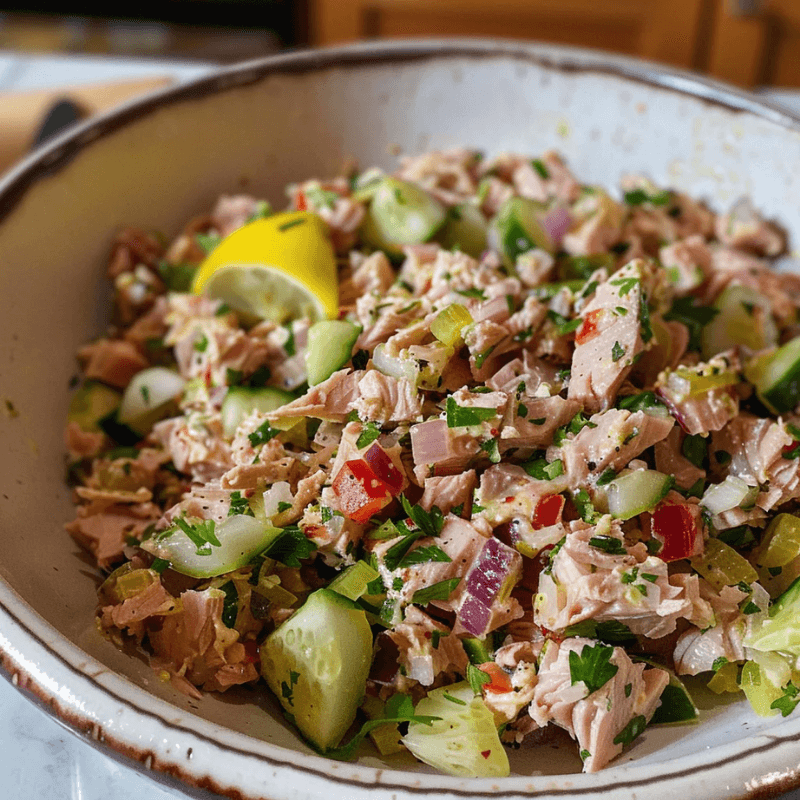
Light, refreshing, and packed with flavor – this Fresh Herbed Tuna Salad is a must-try!
Why chefs prefer specific tuna varieties
Restaurant chefs overwhelmingly reach for albacore tuna when creating premium tuna salads. According to culinary experts, albacore’s meatiness and substantial texture hold up beautifully against moist ingredients like mayonnaise and pickles. Additionally, albacore’s milder flavor profile allows other ingredients to shine instead of overwhelming the salad with fishiness.
Creamline Chef/Owner Harris Mayer specifically recommends line-caught albacore tuna for its “clean and lean flavor”. This professional preference isn’t just about taste—it’s about creating the ideal foundation for a Fresh Herbed Tuna Salad where herbs and seasonings can truly shine.
For those looking to experiment, some chefs suggest combining albacore with chunk light tuna for the perfect balance. Food Network notes albacore’s hearty texture complements the softer, flakier texture of light tuna varieties. This combination creates interesting textural contrast while maintaining the dish’s integrity.
Fresh vs. canned: A chef’s perspective
Fresh tuna offers higher levels of omega-3 fatty acids compared to canned varieties. However, most professional chefs recognize that canned tuna provides practical advantages that often make it the preferred choice for tuna salad preparations.
Consider these chef-acknowledged differences:
- Shelf life: Fresh tuna lasts approximately one week after harvest, whereas properly stored canned tuna remains viable for three to five years.
- Cooking impact: Canned tuna undergoes thorough cooking during processing, which affects its texture and moisture content compared to fresh tuna’s more delicate preparation.
- Convenience factor: Canned tuna provides consistent quality year-round without requiring special storage considerations.
Important to realize is that the canning process fundamentally transforms tuna’s character. As one expert explains, “Canned tuna isn’t just cooked, it’s over-cooked” to ensure food safety. This process creates that distinctive flaky texture that works so well in herb-forward tuna salad recipes.
How to identify premium canned tuna
Selecting restaurant-quality canned tuna involves understanding several key indicators:
First, examine the type designation. “White tuna” always indicates 100% albacore, while “light tuna” may contain skipjack or a combination of different species. Above all, look for albacore when creating a premium Fresh Herbed Tuna Salad.
Second, consider the packing medium. Chefs often prefer different options depending on the final application:
- Water-packed tuna: Ideal when you want to control seasoning and flavor, allowing herbs to shine through.
- Oil-packed tuna: Creates a richer mouthfeel with “subtle fruity, peppery notes” from olive oil.
Third, assess texture upon opening. Premium tuna should feature “large, meaty flakes” rather than mushy consistency. According to taste testers, quality tuna should be “sturdy enough to toss into a salad but also delicate enough to flake apart gently when prodded with a fork”.
Furthermore, be mindful of sustainability certifications. The Marine Stewardship Council (MSC) certification—indicated by a blue fish logo—confirms responsible fishing practices. For conscientious chefs, terms like “pole-caught,” “troll-caught,” and “FAD-free” indicate more selective fishing methods that reduce bycatch.
Finally, drain canned tuna properly before incorporating it into your Fresh Herbed Tuna Salad. As professional chefs emphasize, “Always drain the liquid from the can of tuna before making tuna salad. You want your dish creamy, not soggy”.
Herb Combinations That Transform Your Tuna Salad
The careful selection of herbs makes all the difference between an ordinary tuna sandwich and a Fresh Herbed Tuna Salad that rivals restaurant offerings. Fresh herbs infuse bright flavors, vibrant colors, and aromatic complexity that elevate this simple dish to gourmet status.
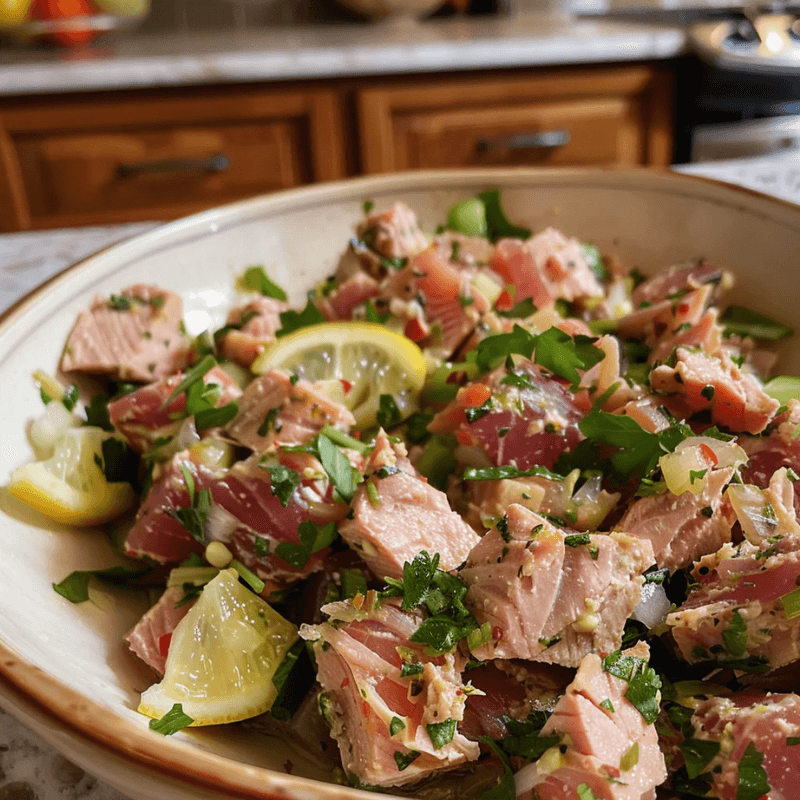
Fresh herbs, flaky tuna, and a zesty dressing – the perfect healthy meal!
Classic herb trios that professional chefs swear by
Professional chefs rely on specific herb combinations to create perfectly balanced tuna salads. The most celebrated trio is dill, parsley, and basil – each herb contributing a distinct flavor profile to the mix.
Dill provides a distinctive, slightly sweet flavor that pairs exceptionally well with seafood. As one culinary expert notes, dill creates a “well-seasoned salad with distinctive dill flavor” making it a favorite lunch recipe. Its delicate feathery texture also adds visual interest to the finished dish.
Parsley adds brightness and a fresh, clean taste. It’s not just for garnish—parsley “adds a burst of color and a light, herby flavor that brightens up the salad”. Its mild flavor makes it an excellent foundation herb that complements without overwhelming.
For an unexpected twist, basil brings a sweet, slightly peppery note that transforms traditional tuna salad into something special. Chefs particularly value fresh basil in summer months when this aromatic herb is at its peak.
Seasonal herb adaptations
Seasonal cooking principles apply even to simple dishes like tuna salad. Throughout the year, I adapt my Fresh Herbed Tuna Salad based on herb availability and seasonal pairings.
In spring, cilantro and mint create a refreshing profile. “Fresh dill and parsley are delicious in a tuna salad, but sometimes I like to change it up and use basil or mint”. This unexpected combination creates a bright, zesty flavor perfect for warmer months.
For fall and winter, oregano adds earthiness and warmth. Although less common in tuna preparations, fresh oregano introduces a robust Mediterranean character. Paired with a touch of lemon zest, it creates a satisfying cold-weather variation.
When fresh herbs aren’t available, dried herbs can substitute in a pinch, yet require adjustment. “Dried herbs can be substituted, make sure to adjust the amount because they are stronger than fresh herbs”. Generally, use one-third the amount of dried herbs compared to fresh.
Proper herb preparation techniques
The way you handle herbs significantly impacts your Fresh Herbed Tuna Salad’s final flavor. First of all, always opt for fresh herbs when possible. “Dried herbs will not taste as good in this salad”. The bright, complex flavors of fresh herbs simply cannot be replicated with dried alternatives.
Proper washing is essential—rinse herbs under cool water and thoroughly pat dry with paper towels or use an herb spinner. Moisture dilutes flavors and affects the salad’s texture.
For fine herbs like dill and parsley, chop just before mixing into your tuna. “Use fresh herbs. If you don’t have all the herbs that the recipe calls for, double up on what you have”. This flexibility allows you to maintain proper herb ratios even when your herb drawer isn’t fully stocked.
Test and adjust your herb balance before serving. “Not bright enough on your palate? Add another squeeze of lemon juice!”. The acid from citrus enhances herb flavors while balancing the richness of mayonnaise or olive oil. Sometimes, “¼ teaspoon of balsamic vinegar” provides that perfect finishing note when herbs alone need a boost.
Through thoughtful herb selection and proper preparation, your Fresh Herbed Tuna Salad transforms from an everyday sandwich filling to a chef-worthy creation worthy of the finest restaurant menus.
Chef-Approved Techniques for Perfect Texture
Texture is the unsung hero of exceptional tuna salad. Indeed, mastering the textural elements separates a mediocre sandwich filling from a Fresh Herbed Tuna Salad worthy of culinary praise. Professional chefs understand that creating the perfect mouthfeel requires attention to specific techniques that many home cooks overlook.
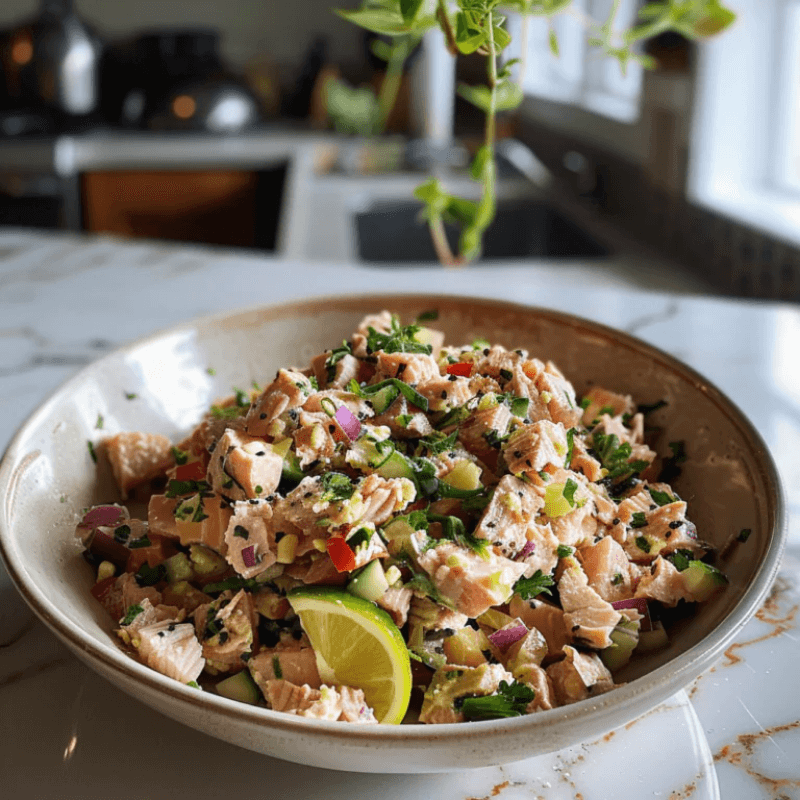
Bright, herby, and protein-packed – this Fresh Herbed Tuna Salad is a game changer!
The correct way to flake tuna
The way you break apart tuna significantly impacts your salad’s final texture. For premium results, start with thoroughly draining the tuna. Chef and Food Network finalist Michael Proietti recommends using tuna packed in olive oil since it “gives the fish a juicier and more tender texture”.
Conversely, if using water-packed tuna, proper draining becomes even more critical. Professional chefs suggest this method: completely detach the can’s lid, press it firmly against the tuna, then invert the can to drain excess liquid. This technique compacts the tuna into a dry disk at the bottom of the can.
Subsequently, when flaking tuna:
- For chunky texture: “Keep the albacore in big pieces instead of flaking it” to create “a more robust and satisfying salad”
- For smoother consistency: “Thoroughly mix/mash the tuna so it gets shredded and broken up into very small pieces”
Essentially, your flaking technique should match your desired end result – larger chunks provide satisfying bites, while finer flakes blend more uniformly with herbs and dressing.
Achieving the ideal moisture balance
Moisture control makes or breaks a Fresh Herbed Tuna Salad. “A watery tuna salad is not your friend,” as excess liquid dilutes flavors and creates an unappetizing consistency.
After draining, many chefs go a step further: “Pat it completely dry with paper towels. Drying the tuna ensures the salad isn’t watery and helps the mayo adhere better, for a creamier texture”. This extra step might seem fussy, but it’s transformative.
For this reason, chef Genevieve Ashworth recommends “pre-chilling all the ingredients—even the tuna—before creating the salad”. This anticipates that olive oil can become “solid and sometimes even gel-like at temperatures below 45°F,” so allowing it to warm slightly before preparation is crucial.
Primarily, achieving perfect moisture requires balance—not too dry, not too wet. As one technique demonstrates, “Drain most but not all of the liquid out (although this will depend mostly on how wet or dry you prefer your tuna salad)”. Some moisture retention helps the ingredients bind together harmoniously.
Creating textural contrast with vegetables
The finest Fresh Herbed Tuna Salad incorporates vegetables that provide crunch against the tender tuna. As one chef states, “I like a lot of crunchy vegetables in my tuna salad, not just for flavor, but also for much-needed texture”.
Vegetable additions that professional chefs recommend include:
- Celery: Provides “a crisp, fresh crunch and a slight peppery flavor”
- Red onion: “A triple threat” that “adds flavor, crunch, and color”
- Water chestnuts: Offer “a snappy texture without overshadowing other ingredients”
- Pickles: “Compliment the creamy mayo with vinegar” while adding crunch
To maximize textural contrast, “Dice or grate all of the veggies small. This will make sure that you have a little bit of everything in every bite”. Moreover, Chef Vermiglio suggests “lightly salting any freshly cut vegetables and allowing them to drain in a colander to remove excess moisture before adding them to your salad”.
When these techniques are thoughtfully applied, your Fresh Herbed Tuna Salad achieves the perfect balance of flaky fish, creamy dressing, and satisfying crunch that makes each bite interesting and delicious.
Balancing Flavors Like a Professional Chef
Professional chefs rely on a deceptively simple framework when creating a memorable Fresh Herbed Tuna Salad—one that transforms ordinary ingredients into extraordinary flavors through careful balance and unexpected additions.
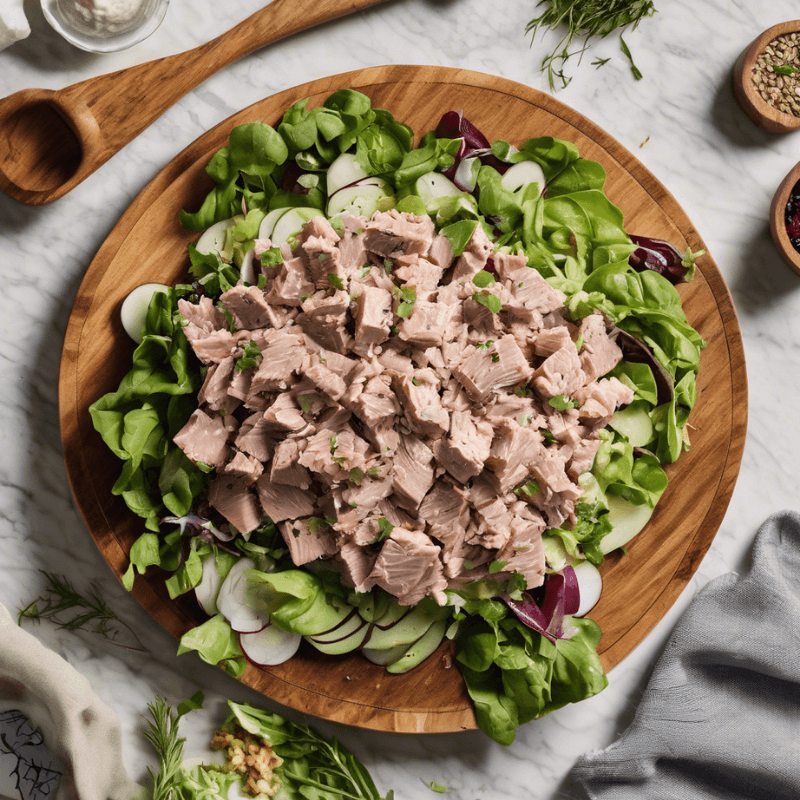
A fresh twist on a classic! This Herbed Tuna Salad is light, flavorful, and oh-so-delicious!
The acid-fat-salt triangle
Creating a restaurant-quality Fresh Herbed Tuna Salad depends on balancing the holy trinity of flavor components. At its core, every exceptional tuna salad requires:
Fat: Chefs unanimously agree on using mayonnaise, though preferences range from Hellmann’s to Duke’s. This creamy base provides richness and body.
Acid: Fresh lemon or lime juice adds essential brightness that cuts through richness. As one chef explains, “I love a tiny squeeze of lemon juice to balance out the richness of the mayonnaise and cut through the fishy taste of the tuna”.
Salt: Beyond table salt, professionals incorporate “pickle-y” elements like capers, cornichons, and pickled cucumbers that contribute both salinity and texture.
Using unexpected ingredients for depth
Besides conventional additions, chefs incorporate surprising elements that elevate Fresh Herbed Tuna Salad:
Chef Matthew McConaughey adds wasabi mixed with mayo for unexpected heat, plus apple and agave syrup for sweetness. Nonetheless, professional chefs often introduce:
- Sharp cheddar cheese for richness in Southern-style preparations
- Minced serrano peppers for controlled heat
- A dash of soy sauce instead of vinegar for umami complexity
- Crispy jalapeño chips for textural contrast
Many culinary experts suggest trying apple cider vinegar or a touch of Dijon mustard to add tanginess without overwhelming other flavors.
Tasting and adjusting: The chef’s method
Throughout the preparation process, chefs continually taste and refine. Following the simple yet crucial advice: “Taste and adjust the seasoning with salt and freshly ground black pepper, if necessary”.
After initial mixing, many recommend chilling the Fresh Herbed Tuna Salad before serving. Chef Carla confirms this is “a behind-the-scenes pro technique that allows the flavors time to meld”. Certain preparations benefit from overnight refrigeration, as “the perfect deli tuna salad is less about the specific ingredients and more about the preparation”.
Upon serving, final adjustments might include “another tablespoon of mayonnaise if needed” or “a half squeeze of lemon juice to revive it” if prepared in advance.
Plating and Presentation Secrets
Eating begins with our eyes, making the presentation of your Fresh Herbed Tuna Salad just as important as its flavor. Master chefs understand that visual appeal transforms a simple dish into an unforgettable culinary experience.
Restaurant-style serving ideas
Professional chefs present tuna salad in multiple ways to enhance its appeal. First of all, consider these elegant serving options:
- Classic vehicles: Toasted whole-wheat bread, saltine crackers, or green salad create perfect foundations for traditional preparations
- Artisanal breads: Sourdough and rye breads especially complement tuna melts with their distinctive flavors
- Edible containers: Hollow out juicy tomatoes and fill with tuna salad for an old-fashioned, yet impressive lunch entrée
Chef Carla recommends “looking beyond bread” to serve tuna salad on sweet potatoes or wrapped in collard greens. Naturally, lettuce cups provide a refreshing, low-carb alternative—romaine and butter lettuce work particularly well as edible vessels.
Garnishing techniques that elevate appearance
Strategic garnishing instantly elevates your Fresh Herbed Tuna Salad from ordinary to restaurant-quality. “Arranging a ‘mindful’ salad is very soothing,” notes one culinary expert. This deliberate, unhurried approach transforms simple ingredients into visual art.
For elegant presentation, place each component intentionally rather than mixing everything together. Consequently, individual ingredients maintain their visual identity, creating what one chef calls “a feast for all the senses.”
Together with thoughtful arrangement, consider adding complementary garnishes like dill sprigs, lemon wedges, or microgreens that echo flavors within the salad itself. These final touches contribute both beauty and cohesive flavor.
Color theory in food presentation
Chefs intentionally manipulate food colors to enhance visual appeal. “I love dishes with many colors because I can enjoy the beauty with my eyes before I enjoy the taste,” explains one food artist.
Granted, color does more than please the eye—it fundamentally shapes our perception of food. Color cues help determine freshness and ripeness, thereby influencing our expectations before the first bite.
To create visually stunning Fresh Herbed Tuna Salad presentations, strive for a spectrum of vibrant, contrasting colors. One chef describes being “mesmerized by the beauty of natural colors” while preparing ingredients. Meanwhile, research confirms that “having a variety of colors” is key to creating exciting salads that stimulate both appetite and mood.
Conclusion
Fresh Herbed Tuna Salad stands as proof that everyday ingredients can yield extraordinary results. Through careful tuna selection, thoughtful herb combinations, and professional techniques, this humble dish transforms into something worthy of any restaurant menu.
My experience shows that success lies in the details – selecting premium albacore tuna, balancing fresh herbs perfectly, and mastering texture through proper preparation. Additionally, understanding the interplay between acid, fat, and salt ensures each bite delivers restaurant-quality flavor.
Remember that presentation matters just as much as taste. Mindful plating and garnishing turn this elevated tuna salad into a feast for both eyes and palate. While mastering these techniques takes practice, the results make every effort worthwhile.
After trying these chef-tested methods, you’ll never look at tuna salad the same way again. This recipe proves that with the right knowledge and attention to detail, home cooks can create dishes that rival those found in professional kitchens.

Welcome to HealthyBlog365, your go-to destination for all things food and drink. We believe that every meal is not just a way to nourish your body but also a meaningful connection with yourself and your loved ones.
HealthyBlog365 was created with a mission to inspire healthy living through nutritious meals and refreshing beverages. Here, you’ll discover a treasure trove of creative recipes, kitchen tips, and healthy eating trends tailored to fit modern lifestyles.
 What can you find on HealthyBlog365?
What can you find on HealthyBlog365?
- Delicious and easy-to-make recipes: From simple meals for busy mornings to wholesome dinners for family gatherings, we’ve got you covered for every occasion.
- Nutritious drinks: Explore recipes for juices, smoothies, detox teas, and drinks that cleanse your body, boost your mood, and energize your day.
- Guides on eating habits: Get detailed insights into popular diets like keto, low-carb, and vegetarian-friendly meal plans.
- Kitchen hacks: Discover smart tips to save time, preserve food, and cook more efficiently.
We are committed to providing high-quality content, staying up-to-date with the latest trends, and maintaining a balance between nutrition and flavor.
 Connect with HealthyBlog365 on Social Media
Connect with HealthyBlog365 on Social Media
Join the HealthyBlog365 community on social media platforms to stay updated with our latest posts, watch exciting tutorials, and share your food stories with us:
Facebook: Follow us here to stay updated with our latest posts and join our community.
Instagram: Check us out here for inspiring visuals and ideas.
Pinterest: Pin with us here to save creative ideas you’ll love.
YouTube: Subscribe here for detailed tutorials and exciting videos.
 Thank You for Supporting HealthyBlog365!
Thank You for Supporting HealthyBlog365!
We aim to build a connected community where everyone can share and learn from each other. If you have any questions or suggestions, don’t hesitate to reach out to us via social media or our website.
We hope you have a wonderful time on HealthyBlog365 and find new inspiration for your healthy culinary journey!
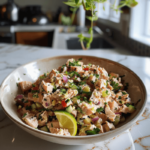
Fresh Herbed Tuna Salad
Description
Ingredients
- 1 5 oz can high-quality tuna, drained
- 2 tbsp fresh parsley finely chopped
- 1 tbsp dill fresh or dried
- 1 tbsp fresh lemon juice
- ¼ cup red onion diced
- ½ cup celery chopped
- ½ cup plain Greek yogurt
Instructions
- Prepare the Vegetables: Wash and finely chop the red onion and celery.
- Mix the Dressing: In a large bowl, combine Greek yogurt and lemon juice until smooth. Stir in parsley and dill.
- Add the Tuna: Flake the drained tuna into the dressing mixture.
- Combine Ingredients: Gently fold in red onion and celery until evenly coated.
- Taste and Adjust Seasoning: Add salt, pepper, or more lemon juice to taste.
- Serve Immediately or Chill: Serve right away or refrigerate for one hour to enhance flavors.
